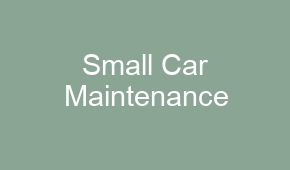Small Car Maintenance

Summary: Small car maintenance is essential for optimal performance. Regularly check oil levels, tire pressure, and fluid levels. Change oil and filters as recommended. Keep the car clean and inspect brakes regularly.
Maintaining a small car is essential for its longevity and optimal performance. Regular oil changes are crucial to keep the engine running smoothly. Tire rotations should be done every 5,000 miles to ensure even wear and extend tire life. Brake inspections are necessary to guarantee safe stopping distances. Fluid checks and top-ups are vital to prevent engine overheating and component failure. Replacing air filters regularly improves fuel efficiency and engine performance. Checking and replacing worn-out wiper blades enhance visibility during rainy weather. Following these small car maintenance practices will save you money in the long run and keep your vehicle running smoothly.
| Regular oil changes are crucial for small car maintenance. |
| Proper tire pressure ensures better fuel efficiency and extends tire life. |
| Check your car’s brake fluid regularly for optimal brake performance. |
| Replacing air filters regularly improves engine performance and fuel economy. |
| Small car maintenance includes checking and topping up fluids like coolant and windshield washer fluid. |
- Rotate tires regularly to ensure even wear and extend tire life.
- Inspect spark plugs and replace as needed for smooth engine operation.
- Clean and wax your car regularly to protect the paint and maintain its shine.
- Inspect and replace worn-out wiper blades for clear visibility during rain or snow.
- Regularly check and clean the battery terminals to prevent corrosion and ensure proper electrical connections.
What are the common maintenance tasks for small cars?
Regular maintenance tasks for small cars include oil changes, tire rotations, brake inspections, and fluid level checks.
It is important to check the owner’s manual for the recommended maintenance schedule and follow it accordingly.
Other common maintenance tasks may include air filter replacements, spark plug replacements, and battery inspections.
How often should I change the oil in my small car?
The frequency of oil changes in small cars can vary depending on the driving conditions and the type of oil used.
Typically, it is recommended to change the oil every 3,000 to 5,000 miles or every 3 to 6 months.
Regular oil changes are important to maintain the engine’s performance and extend its lifespan.
What are the signs of a failing battery in a small car?
Signs of a failing battery in a small car include dim headlights, slow engine cranking, and difficulty starting the car.
If you experience these symptoms, it is advisable to have the battery tested and, if necessary, replaced by a professional.
Regularly cleaning the battery terminals and ensuring a secure connection can help prevent battery issues.
How often should I replace the air filter in a small car?
The frequency of air filter replacements in small cars depends on the driving conditions and the manufacturer’s recommendations.
Generally, it is recommended to replace the air filter every 12,000 to 15,000 miles or approximately once a year.
A clogged or dirty air filter can restrict airflow to the engine, affecting its performance and fuel efficiency.
How can I improve the fuel efficiency of my small car?
To improve fuel efficiency in a small car, maintain proper tire pressure, avoid aggressive driving, and remove excess weight.
Regularly check and replace worn spark plugs, use the recommended grade of motor oil, and keep up with maintenance.
Using cruise control on highways and avoiding excessive idling can also contribute to better fuel efficiency.
What are the signs that my small car needs new brake pads?
Signs that a small car may need new brake pads include squeaking or squealing noises when braking and reduced braking performance.
If you notice vibration or pulsation when applying the brakes or thin brake pad depth, it is advisable to have them inspected and replaced.
Properly functioning brake pads are crucial for safe and effective braking in small cars.
How often should I rotate the tires on my small car?
It is recommended to rotate the tires on a small car every 5,000 to 8,000 miles or every 6 months.
Tire rotation helps even out tire wear and ensures optimal handling and traction for all wheels.
Consult the vehicle’s manual or check with a professional for the specific tire rotation interval for your small car.
What are the benefits of regular small car maintenance?
Regular small car maintenance improves safety, extends the lifespan of the vehicle, and prevents costly repairs.
It ensures reliable performance, optimal fuel efficiency, and compliance with warranty requirements.
Additionally, regular maintenance allows for early detection of potential issues, preventing them from escalating.
How can I maintain the exterior of my small car?
To maintain the exterior of a small car, wash it regularly using a mild car wash soap and protect it with wax.
Avoid parking under direct sunlight for extended periods and remove bird droppings promptly to prevent paint damage.
Using a protective car cover and avoiding harsh chemicals can further help preserve the exterior of the small car.
What should I do if my small car overheats?
If a small car overheats, pull over safely, turn off the engine, and wait for it to cool down.
Check the coolant level and ensure there are no leaks. If necessary, add coolant or seek professional assistance.
Driving an overheated small car can cause serious engine damage, so it’s essential to address the issue promptly.
How often should I check the tire pressure in my small car?
It is recommended to check the tire pressure in a small car at least once a month or before long trips.
Use a tire pressure gauge to ensure the tires are properly inflated according to the manufacturer’s recommendations.
Proper tire pressure promotes optimal handling, fuel efficiency, and tire longevity.
What are the benefits of using synthetic oil in a small car?
Using synthetic oil in a small car provides better engine protection, improved fuel efficiency, and extended oil change intervals.
It offers superior resistance to temperature extremes, reduces engine wear, and enhances engine cleanliness.
While synthetic oil may have a higher upfront cost, the long-term benefits make it a worthwhile investment for small car owners.
What should I do if my small car won’t start?
If a small car won’t start, check the battery connections, ensure the vehicle is in park or neutral, and try jump-starting the car.
If the problem persists, it may be due to a faulty starter or ignition system, requiring professional diagnosis and repair.
Regular maintenance can help prevent starting issues in small cars.
How can I keep my small car’s interior clean?
To keep a small car’s interior clean, regularly vacuum the carpets and wipe down surfaces with a damp cloth.
Use interior cleaners specifically designed for different materials, such as leather or fabric.
Avoid eating or drinking in the car, and clean up spills promptly to prevent stains and odors.
What is the recommended tire tread depth for small cars?
The recommended tire tread depth for small cars is at least 1/16 of an inch or 1.6 millimeters.
Using a tire tread depth gauge can help determine if the tires meet the minimum requirement.
Worn-out tires with insufficient tread depth can negatively impact traction and handling, especially in wet or snowy conditions.
How can I protect my small car’s paint from scratches?
To protect a small car’s paint from scratches, avoid parking too close to other vehicles or objects.
Consider applying a paint protection film or using a car cover when the vehicle is not in use.
Regularly wash and wax the car to maintain a protective layer on the paint surface.
What should I do if my small car’s check engine light comes on?
If the check engine light comes on in a small car, it indicates a potential issue with the engine or emissions system.
It is advisable to schedule a diagnostic check with a professional to identify the specific problem.
Ignoring the check engine light can lead to more severe damage and costly repairs in the long run.





















